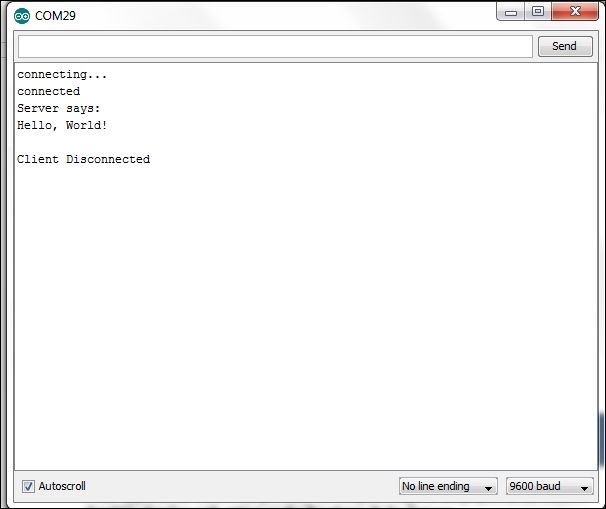In this task, we will review the
python-twisted framework (https://twistedmatrix.com/trac/). The Twisted framework is an open source event-driven network engine that can be used to send control messages to other devices (for example, a pet feeder can be operated using Raspberry Pi to dispense solid food to our animal friends). The messaging protocol is called
AMP (Asynchronous Messaging Protocol) which is available at http://amp-protocol.net/.
The Raspberry Pi (with an SD card flashed with the OS image) connected to the Internet is needed for this task along with an Arduino Ethernet Board (or any one of the boards mentioned earlier in the checklist. Network connectivity is essential). We will install the python-twisted framework and review a quick example to exchange messages between Arduino and the Raspberry Pi.
- The
python-twistedframework can be installed from the terminal of the Raspberry Pi as follows:sudo apt-get install python-twisted - Once the installation is complete, it is time to review an example of the python-twisted framework to test the framework (http://twistedmatrix.com/documents/current/_downloads/simpleserv.py).
- In this task, we will launch a server on the Raspberry Pi and try to communicate to the server within the local network.
- Let's modify the preceding example to bind the
python-twistedserver to the IP address of Raspberry Pi so that we can exchange messages with other devices on the network. This device can either be an Arduino or a laptop. - We will modify the
listenTCPmethod to bind the server to the IP address of the Raspberry Pi and listen to incoming messages at the port address,8000.reactor.listenTCP(8000,factory,50,'192.168.1.89')
- The web server can be launched by executing a Python script.
- Now, using a laptop that is connected to the same network, let's modify the
simpleclient.pyscript to send and receive messages to the server just launched on the Raspberry Pi (https://twistedmatrix.com/documents/14.0.1/_downloads/simpleclient.py). - In order to connect to the server launched on Raspberry Pi, the
connectTCPmethod needs to be modified to include the IP address that the client has to connect:reactor.connectTCP('192.168.1.89', 8000, f) - In this example, the Raspberry Pi is the server and the laptop is the client. The server in this example echoes all incoming messages. Thus, when the client connects and sends a message, the output will be something like:
Server said: Hello, World! connection lost Connection lost - goodbye!
- Now that we have installed the server, let's discuss a simple Arduino sketch to interact with the server launched on the Raspberry Pi. The sketch is available along with this project's downloads (
TwistedFrameworkTest.ino).- We will get started by declaring an IP address object that includes the IP address of Raspberry Pi:
//MAC Address of the Arduino byte mac[] = { 0x90, 0xA2, 0xDA, 0x0F, 0x02, 0xFC }; //IP Address of the Raspberry Pi IPAddress server( 192, 168, 1, 89); - The Arduino acts as a TCP client and connects to the Raspberry Pi:
if (client.connect(server, 8000)) { Serial.println("connected"); client.println("Hello, World!"); client.println(); //Lets wait for the client to read and //echo the message //Note: A second's delay is a bit excessive delay(1000); //If there is a response from the server //echo back the message Serial.println("Server says:"); while(client.available()) { char c = client.read(); Serial.print(c); } client.stop(); Serial.println("Client Disconnected"); } else { Serial.println("connection failed"); } - The Arduino client connects to the Raspberry Pi and transmits the Hello, World! message. The Raspberry Pi echoes back the message to the Arduino client. A screenshot of the server's response to the client is shown as follows:

Interaction of the Arduino client with the Raspberry Pi
- We will get started by declaring an IP address object that includes the IP address of Raspberry Pi:
- We demonstrated the ability to transmit and receive messages between Arduino and the Raspberry Pi.
